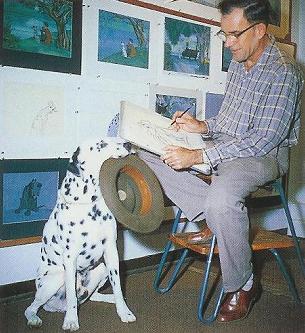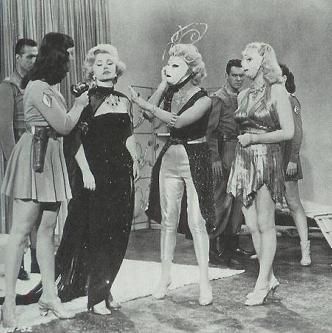Walt Disney Art Classics Convention 2004 - Part 1
Page 6 of 13
Milt Kahl’s earliest drawings were very realistic, Deja pointed out. He illustrated the point with several examples, saying that the initial work showed no real personality. That would be added in later overlays, in order to simplify and stylize the characters.
Deja then showed the work of two animators well known to Disney fans, Frank Thomas and Ollie Johnston. Thomas’ work showed careful analysis and detail.

Frank Thomas studied live models while working on 101 Dalmatians.
Johnston’s version of Perdita cowering under the stove was contrasted with Kahl’s version. “Milt Kahl was the ‘drawing police’ at the Studio,�? Deja chuckled. He then presented a gallery of images, showing minor characters ranging from the TV pitchman to Thunderbolt, the hero of the puppies’ favorite television program.
One amusing sequence of drawings depicted Pongo’s wobbly legged reaction as he learns that he has just become the father of 15 puppies. When the first animation of this was shown in the studio screening room, a young animator remarked “I would never want to work that hard on a sequence.�? Out of the darkness Milt Kahl snapped, “This is Disney. We work that hard here.�?
Deja also showed the work of the other Character Stylist, Tom Oreb. It, too, was improved and refined by Milt Kahl. Among the images were several showing the artists sketching various dogs that were brought into the studio. Deja recalled that during the production of The Lion King, a live lion was brought into the conference room. When the opportunity came to stroke the lion’s mane, Deja said he decided to use his left hand, just in case.
Deja moved on to the major human characters, showing Kahl’s designs for Nanny, Roger and Anita. He focused on Anita, pointing out that initial concepts depicted her as a traditional Disney heroine. But against the stylization of the rest of the characters, her personality couldn’t show strongly. Marc Davis was given the task of designing Anita. Finally, Milt Kahl “pushed the shapes�? to arrive at Anita’s final form.
Deja then grinned and announced that a special surprise guest was on hand: Lisa Davis, the voice of Anita Radcliff. Davis’ entrance was greeted with a warm round of applause. She beamed at the crowd and said, “What a pleasure it is to be here today.�?
After settling into a chair, Davis smiled again as she began, “I want you to know that 101 Dalmatians has been the greatest thrill of my life.�? She went on to say that she had begun acting in England at the tender age of six. At twelve she did a film for David Lean. Walt Disney saw that film, and invited her to come to the United States to work on his film version of Alice in Wonderland. At that time, Davis explained, Disney’s concept was to do a live action Alice with animation all around. After extensive footage was shot, however, the concept was abandoned, due to the great cost it would have incurred. Davis added that years later, a fully animated version was produced, using the voice of her friend, Kathy Beaumont.
Davis continued her story, saying, “Many years later I was in America.�? Television had become a great force in entertainment, and all the great studios went into decline. All except Disney, she said. “That was the Rolls Royce of studios.�? Davis noted ruefully that she had taken work in “bad films. One week wonders. Cheap and cheerful!�? She said that one film was so very bad that “today it’s a good movie.�? Queen of Outer Space starred Zsa Zsa Gabor. Playing Gabor’s assistant in the film, Davis learned to imitate her distinctive voice.

Zsa Zsa Gabor and masked “assistants�? in Queen of Outer Space.
Apparently, Walt Disney learned of Lisa Davis’ unique talent, because he sent for her to test for the role of Cruella de Vil. He wanted the vain puppy-napper to sound like Zsa Zsa. So Davis went over to the Disney studio, excited to read for the part. She expected to read for a casting agent, but instead found herself in a room with Walt Disney himself. She recalled, “It is constantly a thrill to be at that studio.�?
The scene selected was between Anita and Cruella. Walt read the lines for Anita, as Davis read Cruella. But, Davis said, it was all wrong! And how could she possibly tell the great Walt Disney that he was wrong? She finally got up the courage to ask if she could read Anita’s lines, saying, “I am much more of an Anita than Cruella.�? So, Walt read Cruella de Vil’s lines, Davis read Anita’s and, she concluded, “That is why I am sitting here today.�?
Davis mentioned that today, when recording an animated film role, the work is basically all done within a week. But in the heyday of Disney animation, the budget allowed for voice artists to stay for long periods of time. And so Lisa Davis found herself in a cottage with lots of puppies to play with. “What kind of job is that?�? she marveled. Then, when the call came from the studio, she would read one line at a time. The same line all day. For example, “Roger, it’s tea time.�? A few weeks later she would be called back to record… “Roger, it’s tea time.�? “It was wonderful because it was perfection,�? she said, “And that is what you see on the screen.�? Even today, she added, her grandchildren love to hear her say, “It’s tea time.�?
She then admitted there was one line she hates to this day. After Anita falls in the pond, near the beginning of the film, she says, “Oh, what’ll we do?�? Davis despaired of getting it to sound like anything but, “Oh, waddle we do?�? Only later did she decide she should have altered the line to “Oh, what shall we do?�?

A bedraggled Roger and Anita meet in 101 Dalmatians.
